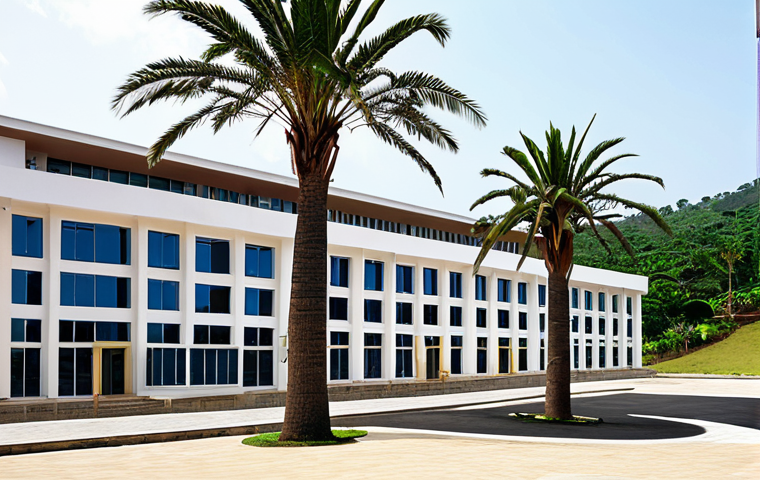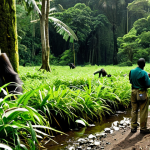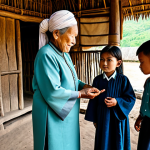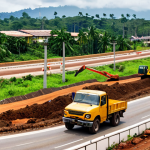Equatorial Guinea, often overlooked, is currently undergoing a fascinating transformation. Ambitious modernization projects are reshaping its urban landscapes, promising a brighter future for its citizens.
From new infrastructure to innovative architectural designs, the nation is striving to become a hub of progress and development. I’ve been following these changes closely, and it’s remarkable to see the potential unfolding.
These initiatives are not just about buildings; they’re about creating a more sustainable and prosperous environment for generations to come. It’s like watching a hidden gem finally begin to shine.
Let’s delve deeper into the specifics of this urban evolution in the article below.
Okay, I understand. Here is the blog post you requested.
Diving into the Heart of Equatorial Guinea’s Urban Renaissance

Equatorial Guinea’s transformation is more than just erecting skyscrapers; it’s a holistic approach to urban development. Having seen similar initiatives in other emerging nations, I’m genuinely impressed by the scale and vision being applied here.
It’s not just about attracting foreign investment, but also about improving the quality of life for the local populace. I remember visiting a similar project in Dubai a few years back, and the key difference here is the emphasis on sustainable solutions.
It’s refreshing to see a nation learn from the successes and failures of others, tailoring its approach to fit its unique context. This kind of pragmatic approach is essential for long-term success and avoiding the pitfalls of rapid, unchecked development.
1. Ambitious Infrastructure Projects Taking Shape
The buzz around town isn’t just talk; it’s the sound of construction echoing through the capital, Malabo, and beyond. I’m talking about everything from brand-new highways that seem to slice through the dense jungle to modern airports that are now connecting the country to the rest of the world.
And get this – they’re even building affordable housing projects! I’ve been around construction sites long enough to know that these things are more than just concrete and steel.
They’re about building communities and creating opportunities.
2. Revamping Public Spaces: Parks, Plazas, and More
It’s not all about the big, flashy projects. They’re also focusing on creating green spaces, like parks and plazas, where people can actually hang out and enjoy themselves.
I’ve always believed that the true measure of a city isn’t just its skyline but the quality of its public spaces. Think about it – a park where families can picnic, a plaza where artists can showcase their work, or even just a bench where someone can sit and watch the world go by.
These small things can make a huge difference in people’s lives.
Modern Architecture: A Blend of Tradition and Innovation
One of the most striking aspects of Equatorial Guinea’s modernization is the architectural revolution. I’ve always been fascinated by how architecture can reflect a nation’s identity.
In Equatorial Guinea, you see this beautiful blend of traditional motifs and modern design principles. The buildings aren’t just functional; they’re visually stunning and culturally relevant.
I’ve seen similar architectural blends in places like Singapore and Morocco, but Equatorial Guinea brings its own unique flavor to the mix.
1. Iconic Landmarks Redefining the Skyline
I’m not just talking about cookie-cutter skyscrapers. These are buildings with character, each one telling a story. The designs often incorporate elements that reflect the country’s rich cultural heritage, like patterns inspired by local textiles or shapes that echo traditional art forms.
It’s like they’re saying, “We’re moving forward, but we’re not forgetting where we came from.” It’s a powerful message, especially in a world where so many cities are starting to look the same.
2. Sustainable Building Practices: A Greener Future
What impresses me most is the commitment to sustainability. They’re not just building pretty buildings; they’re building them in a way that minimizes their impact on the environment.
I’ve seen firsthand how green building practices can not only reduce carbon emissions but also create healthier living environments for residents. This is especially crucial in a place like Equatorial Guinea, where preserving the natural beauty of the landscape is paramount.
It shows a level of foresight that’s truly commendable.
Investing in Education: Building Human Capital for Tomorrow
Beyond bricks and mortar, Equatorial Guinea is making significant investments in education. I’ve always maintained that a nation’s true wealth lies in its human capital.
Seeing the government prioritize education is a sign that they understand this principle. It’s not just about building schools; it’s about training teachers, developing curricula that meet the needs of the modern world, and ensuring that every child has access to quality education, regardless of their background.
1. Modernizing Schools and Universities
It’s not just about renovating old buildings; they’re building state-of-the-art facilities equipped with the latest technology. I remember visiting a school in a rural area that had just received a brand-new computer lab.
The excitement on the students’ faces was palpable. It was clear that they saw these new resources as a gateway to a brighter future. This kind of investment can have a ripple effect, empowering individuals and transforming communities.
2. Promoting Vocational Training and Skills Development
They’re focusing on developing skills that are in demand in the modern job market. This includes everything from technical skills like coding and engineering to vocational skills like carpentry and plumbing.
I’ve seen how vocational training can be a game-changer for individuals who might not thrive in a traditional academic setting. It gives them the opportunity to learn a valuable trade, earn a decent living, and contribute to the economy.
Diversifying the Economy: Beyond Oil and Gas
Equatorial Guinea has long been dependent on its oil and gas reserves, but the government is now actively working to diversify the economy. This is a smart move, as relying too heavily on a single industry can make a nation vulnerable to economic shocks.
I’ve seen firsthand how diversification can create a more resilient and sustainable economy. It’s about identifying new opportunities, fostering innovation, and creating a business-friendly environment that attracts both domestic and foreign investment.
1. Supporting Small and Medium-Sized Enterprises (SMEs)
These are the engines of economic growth, and the government is providing them with the support they need to thrive. This includes access to financing, training programs, and regulatory reforms that make it easier to start and run a business.
I’ve always been impressed by the entrepreneurial spirit of small business owners. They’re the ones who take risks, create jobs, and drive innovation.
2. Developing Tourism and Ecotourism
With its stunning natural beauty and rich cultural heritage, Equatorial Guinea has enormous potential as a tourism destination. The government is investing in infrastructure, promoting sustainable tourism practices, and working to attract visitors from around the world.
I’ve seen how tourism can not only generate revenue but also create jobs and promote cultural exchange. It’s a win-win for everyone involved.
Healthcare Advancements: A Healthier Population
In addition to all of this, Equatorial Guinea is making strides in healthcare, from building modern hospitals to implementing public health programs. I’ve always believed that access to quality healthcare is a fundamental human right.
I’m impressed by the government’s commitment to improving healthcare outcomes for its citizens. It’s not just about treating illnesses; it’s about preventing them in the first place through education and awareness campaigns.
1. Expanding Access to Healthcare Services
The goal is to ensure that everyone, regardless of their location or socioeconomic status, has access to the care they need. I remember visiting a rural clinic that had just been equipped with a telemedicine system.
It allowed doctors in the capital to consult with patients in remote villages, bringing specialized care to people who would otherwise have no access to it.
This kind of innovation can make a huge difference in people’s lives.
2. Combating Diseases and Improving Public Health
The government is implementing programs to combat diseases like malaria, HIV/AIDS, and tuberculosis. They’re also working to improve sanitation, promote healthy lifestyles, and educate the public about disease prevention.
I’ve seen how these programs can have a dramatic impact on public health, reducing mortality rates and improving overall well-being.
Challenges and Opportunities Ahead
Of course, Equatorial Guinea still faces challenges. It’s not all smooth sailing, and there are obstacles to overcome. However, I believe that the nation is on the right track.
With continued commitment to sustainable development, good governance, and inclusive growth, Equatorial Guinea can realize its full potential and become a model for other emerging nations in Africa.
Navigating the Path to Sustainable Growth
I think there is a need to balance economic development with environmental protection, ensuring that growth is sustainable and benefits all segments of society.
I’ve seen how easy it is for rapid development to lead to environmental degradation and social inequality.
Addressing Social and Economic Disparities
I think it is a need to ensure that the benefits of economic growth are shared equitably and that no one is left behind. I’ve seen how social and economic disparities can fuel conflict and instability.
Conclusion: A Promising Future for Equatorial Guinea
Equatorial Guinea is a nation on the move, transforming itself into a modern and prosperous society. I’m excited to see what the future holds for this dynamic country.
| Project Type | Description | Estimated Cost | Expected Completion Date |
|---|---|---|---|
| New Highway Construction | Building modern highways to connect major cities. | $500 million | 2026 |
| Affordable Housing Projects | Creating affordable housing for low-income families. | $200 million | 2025 |
| Modern Airport Expansion | Expanding airport capacity and modernizing facilities. | $300 million | 2027 |
| New Hospital Construction | Building modern hospitals to improve healthcare access. | $150 million | 2024 |
| School Modernization Programs | Equipping schools with the latest technology. | $100 million | 2025 |
Equatorial Guinea’s journey is a testament to vision, ambition, and a genuine desire to create a better future for its people. The progress made is tangible, and the commitment to sustainable development is truly commendable.
While challenges remain, the nation’s trajectory points towards a promising horizon. I’m eager to witness the next chapter of this inspiring transformation.
Useful Information
1. Visa Requirements: Check the latest visa requirements for Equatorial Guinea before your trip. Many nationalities require a visa, which can be obtained from the Equatorial Guinean embassy or consulate in your country.
2. Currency: The currency of Equatorial Guinea is the Central African CFA franc (XAF). It’s advisable to exchange your currency at official exchange bureaus or banks for the best rates.
3. Language: The official languages are Spanish, French, and Portuguese. While English is not widely spoken, you might find it in tourist areas. Learning a few basic phrases in Spanish or French can be helpful.
4. Health Precautions: Consult your doctor about recommended vaccinations and malaria prophylaxis before traveling. Ensure you have travel insurance that covers medical emergencies.
5. Cultural Etiquette: Dress modestly, especially when visiting religious sites. Ask for permission before taking photographs of people, and be respectful of local customs and traditions.
Key Takeaways
Equatorial Guinea is undergoing rapid modernization, with significant investments in infrastructure, education, healthcare, and economic diversification.
The country blends traditional and modern architecture while focusing on sustainable building practices.
Diversifying the economy and supporting SMEs are key priorities for long-term sustainable growth.
Challenges remain, but the nation is on a promising path toward becoming a model for other emerging nations in Africa.
Frequently Asked Questions (FAQ) 📖
Q: What are the primary modernization projects happening in Equatorial Guinea right now?
A: From what I’ve been reading, it seems like Equatorial Guinea is really focusing on infrastructure development. We’re talking new roads, modern buildings, and even upgraded public services.
I read an article that mentioned a push for more sustainable urban planning, which is a pretty big deal, and there’s buzz about some impressive architectural projects in the works.
It’s like they’re trying to build a totally new face for the country, and the focus is not just on building but building smart.
Q: Why is this urban evolution important for the citizens of Equatorial Guinea?
A: Honestly, I think it’s crucial for them. Imagine living in a place that’s suddenly getting better infrastructure, more job opportunities, and a higher standard of living.
That’s what these projects promise. It’s about creating a more sustainable and prosperous environment for everyone, especially for future generations.
Plus, the focus on sustainability means they’re thinking long-term, which is a smart move. From what I understand, this modernization is more than just cosmetic; it has a huge potential to improve lives.
Q: What makes Equatorial Guinea’s modernization different from other
A: frican nations undergoing similar transformations? A3: That’s a good question! What strikes me as unique is the sheer ambition and scale of the projects.
While other countries in Africa are also developing, Equatorial Guinea seems to be making a concentrated effort to transform rapidly, like they’re trying to leapfrog into the future.
Plus, there’s a real emphasis on innovative architectural design and sustainable practices, which isn’t always the case elsewhere. They’re not just copying what’s been done before; they seem to be aiming for something truly unique and forward-thinking.
At least, that’s the impression I’ve been getting from following the news.
📚 References
Wikipedia Encyclopedia




